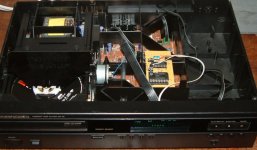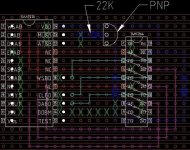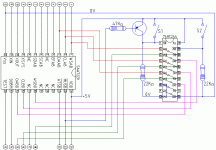first point, this is NOT a rant about the relative merits of one topology vs another, more an encouragemnent to find out yourself which suits YOU better. I'm putting this up because I've never seen it anywhere so I hope its not a re-post.
I recently managed to get a working Marantz CD40 off EBay for the pribcely sum of £9.99 result! first step was to remove all the op-amps, the TDA1541A and the SAA7220G/P and bung in some sockets (tip - solder wick is great)
I replaced the op-amps with OPA2134's, just because I could rather than to further the course of my grand experiment.
Next - 1 daughter board taking the pins of the SAA7220 up amd through a tristate buffer (74LS244) so that in one condition the data passed through the circuits as Marantz intended, in the other the data went straight across the O/S filter and into the DAC.
Muting was acomplished with a transistor on the 74LS244 so that if mute is low into the defeated SAA7220 (non o/s mode) then the 'LS244 is turned off and you dont get the chirps and clicks during the skipping to or forwarding of tracks.
bung a switch on the front to change between modes and you have a player that can do it both ways. With all other things being equal.
BTW I was concerned for a while about the 'filterless' non-OS doing damage to the rest of my system. Ultimately I figured that the rest of the player's output stage would chop out much of the ultrasonics anyway. it not being designed to effectively amplify 100Khz signals. (Doesnt mean I'd want to try this with a MOSFET amp though, Personally I'd be worrying about ultrasonic oscillation but that may be unfounded)
And the difference? well not to spoil it for you, it was more subtle than I expected. But consistent across the small number of CD's / amplifiers I tried it with,
Andy
I recently managed to get a working Marantz CD40 off EBay for the pribcely sum of £9.99 result! first step was to remove all the op-amps, the TDA1541A and the SAA7220G/P and bung in some sockets (tip - solder wick is great)
I replaced the op-amps with OPA2134's, just because I could rather than to further the course of my grand experiment.
Next - 1 daughter board taking the pins of the SAA7220 up amd through a tristate buffer (74LS244) so that in one condition the data passed through the circuits as Marantz intended, in the other the data went straight across the O/S filter and into the DAC.
Muting was acomplished with a transistor on the 74LS244 so that if mute is low into the defeated SAA7220 (non o/s mode) then the 'LS244 is turned off and you dont get the chirps and clicks during the skipping to or forwarding of tracks.
bung a switch on the front to change between modes and you have a player that can do it both ways. With all other things being equal.
BTW I was concerned for a while about the 'filterless' non-OS doing damage to the rest of my system. Ultimately I figured that the rest of the player's output stage would chop out much of the ultrasonics anyway. it not being designed to effectively amplify 100Khz signals. (Doesnt mean I'd want to try this with a MOSFET amp though, Personally I'd be worrying about ultrasonic oscillation but that may be unfounded)
And the difference? well not to spoil it for you, it was more subtle than I expected. But consistent across the small number of CD's / amplifiers I tried it with,
Andy
Attachments
poynton said:hi.
What are the functions of S1 and S2?
Andy
You cannot be serious!
s1 open, s2 closed = non-os mode
s1 closed, s2 open = oversampled
s1 closed, s2 closed = silence
s1 open , s2 open = noise, lots of noise...
closing s1 makes the 1 output enable high when connected i.e. disables the data through the 1 channel, meaning if S2 is open then its over sampled data that's sent back to the mainboard.
Andy
s1 closed, s2 open = oversampled
s1 closed, s2 closed = silence
s1 open , s2 open = noise, lots of noise...
closing s1 makes the 1 output enable high when connected i.e. disables the data through the 1 channel, meaning if S2 is open then its over sampled data that's sent back to the mainboard.
Andy
And the difference? well not to spoil it for you, it was more subtle than I expected. But consistent across the small number of CD's / amplifiers I tried it with,
Andy [/B]
Could you please spend some more words on this..
I tried it with Musical fidelity amps / pre-amps but only 3 in total and all with castle Harlech speakers, None of this is famed for being big and Bassy, so I cant say that everyone will get the same experience in their system.
I was expecting a big change in the sound. The SAA7220 is apparently not the best filter and the TDA1541A apparently excels in non-OS mode. But there is a bigger difference between flicking to NON-OS from OS mode than going the other way
what else can I say aside from the reams of opinion about one or the other already on this forum. much of which is backed up by some kind of measurement. or greater experience.
Personally I'd rather not get involved in the bun-fight, is one better than the other? depends.
I was expecting a big change in the sound. The SAA7220 is apparently not the best filter and the TDA1541A apparently excels in non-OS mode. But there is a bigger difference between flicking to NON-OS from OS mode than going the other way
what else can I say aside from the reams of opinion about one or the other already on this forum. much of which is backed up by some kind of measurement. or greater experience.
Personally I'd rather not get involved in the bun-fight, is one better than the other? depends.
1-
I was expecting a big change in the sound.
2.
But there is a bigger difference between flicking to NON-OS from OS mode than going the other way
3.
what else can I say aside from the reams of opinion about one or the other already on this forum. much of which is backed up by some kind of measurement. or greater experience.
4.
is one better than the other? depends. [/B]
Ok
Ok
So the difference is rather subtle
Without getting us in whatever kind of fight,
I like to get an impression of the character of the effects before "digging in"
My guess would be:
from OS to NOS:
- more natural more rough less refined ?
from NOS to OS
- more closed in artificial smooth?
Can you relate to this in any way or do you think these are highly subjective qualifications ?
Leonar,
I think the whole non- oversampling vs Oversampling debate is rather subjective. I would certainly not be able to accurately say A vs B unless I could change as music was playing - maybe I'm not a subtle guy
BUT,
you are more or less correct in your observations, Non OS appears more open subjectively (like having a touch more volume). its very hard to describe. Not rough though, for instance female vocals really seem to shine
Oversampled is more correct (I think, I'm not a musician) I would prefer Non-OS on piano or acoustic music, and Oversampled on electronic / pop music.
I think ultimately your preference for one or the other will be based on a preference for 'technically' correct vs musical. I honestly think that experimenting in this reversible way allows you to see which you prefer. Have a go, you can always sell the cd player on Ebay!
For me I'll have a filter if I HAD to choose, with a tube o/p stage.
what I find amusing is that Philips, Sony etc put in the Oversampling (€) for a reason that seems to be quite subtle, given that most people will quite happily listen to MP3s or minidisk seems a bit of a wasted effort.
(But I'm glad they did make a decent format - thanks guy's)
Andy
I think the whole non- oversampling vs Oversampling debate is rather subjective. I would certainly not be able to accurately say A vs B unless I could change as music was playing - maybe I'm not a subtle guy

BUT,
you are more or less correct in your observations, Non OS appears more open subjectively (like having a touch more volume). its very hard to describe. Not rough though, for instance female vocals really seem to shine
Oversampled is more correct (I think, I'm not a musician) I would prefer Non-OS on piano or acoustic music, and Oversampled on electronic / pop music.
I think ultimately your preference for one or the other will be based on a preference for 'technically' correct vs musical. I honestly think that experimenting in this reversible way allows you to see which you prefer. Have a go, you can always sell the cd player on Ebay!
For me I'll have a filter if I HAD to choose, with a tube o/p stage.
what I find amusing is that Philips, Sony etc put in the Oversampling (€) for a reason that seems to be quite subtle, given that most people will quite happily listen to MP3s or minidisk seems a bit of a wasted effort.
(But I'm glad they did make a decent format - thanks guy's)
Andy
When you compare OS versus NOS you are really comparing how your amplifier and speakers react to ultrasonics. Ultrasonics can and will produce IM products in the audible range; and this will vary from one amp to the next.
The subjective tests should at least be conducted blindy... so the listener can report their impressions to the "switch-flipper".

The subjective tests should at least be conducted blindy... so the listener can report their impressions to the "switch-flipper".
Andy, many thanks for your impressions.
Sorry for pushing but my idea was that since you can easily change back and forth doing more or less a A/B you would be able to be a little less subjective…
Your remarks on the subtle effects on the sound quality sound familiar
One week ago I went to audio shop and compared my 70 Euro Pioneer DVD player (DV350) with a 1400 Euro Quad CD-P connected to a pair of Quad speakers through a Class A Sugden amp.
I was a bit surprised that there was no more differences between the two.
Yes the Quad was better but only by a nose length as was the case with a Rega Apollo CD-P. Surely the differences were audible but rather modest compared to the difference between different speakers...
The sales person made me aware of the hidden qualities of old cd-ps and the possibility to upgrade.
(In fact that’s why I am here now …)
Your idea with the switch appeals to me
and I am considering doing something similar..
I will not use the remote function for volume control anymore.
I could use the signal of this to control the switch so I can change between NO and NOS with my remote.
What about that …
Leo
Sorry for pushing but my idea was that since you can easily change back and forth doing more or less a A/B you would be able to be a little less subjective…
Your remarks on the subtle effects on the sound quality sound familiar
One week ago I went to audio shop and compared my 70 Euro Pioneer DVD player (DV350) with a 1400 Euro Quad CD-P connected to a pair of Quad speakers through a Class A Sugden amp.
I was a bit surprised that there was no more differences between the two.
Yes the Quad was better but only by a nose length as was the case with a Rega Apollo CD-P. Surely the differences were audible but rather modest compared to the difference between different speakers...
The sales person made me aware of the hidden qualities of old cd-ps and the possibility to upgrade.
(In fact that’s why I am here now …)
Your idea with the switch appeals to me
and I am considering doing something similar..
I will not use the remote function for volume control anymore.
I could use the signal of this to control the switch so I can change between NO and NOS with my remote.
What about that …
Leo
I have three NOS DACs, a TDA1545A, a TDA1543 and a dual PCM56 (internal op-amps bypassed - the best by far). The first uses the same DAC chip and an identical output stage as that used in my CD player. Each NOS DAC uses a CS8414.
The audible differences between the different DAC ICs are much greater than the audible difference between the TDA1545A in OS mode vs NOS mode. NOS mode sounds truer to me despite its spdif interface, OS less clear and a little artificial in comparison. Piano reveals this clearly though everything sounds better to my ears. A 'one-way street'.
Tim.
The audible differences between the different DAC ICs are much greater than the audible difference between the TDA1545A in OS mode vs NOS mode. NOS mode sounds truer to me despite its spdif interface, OS less clear and a little artificial in comparison. Piano reveals this clearly though everything sounds better to my ears. A 'one-way street'.
Tim.
poobah said:When you compare OS versus NOS you are really comparing how your amplifier and speakers react to ultrasonics. Ultrasonics can and will produce IM products in the audible range; and this will vary from one amp to the next.
The subjective tests should at least be conducted blindy... so the listener can report their impressions to the "switch-flipper".

I agree, so I had my family listen too, without saying which was "best" everyone agreed the effect was small. The danger is you hear what you want to hear.
Your point about ultrasonics is also well noted, hence when you are doing something thats mathematically wrong you need to listen for the effects in one particular setting.
I wonder though if these effects are not toned down by the filter thats still present in the CDP. Sure it's not up to the job of MHZ amplification but the unity gain could still be above the slow filter frequency?
So to summarise, and maybe keep everyone happy, you really do have to check for yourself.
My opinion is that there are more obvious ways to affect the sound. Change amp, DAC I/C, transport. output stage etc. and that generally the tweaking in the analogue domain has more of an effect!
What would be interested ios to undertake a similar test with a highly tuned player, maybe there is more 'legroom' with one or the other methodology. but I'm afraid thats another tale...
TimA said:I have three NOS DACs, a TDA1545A, a TDA1543 and a dual PCM56 (internal op-amps bypassed - the best by far). The first uses the same DAC chip and an identical output stage as that used in my CD player. Each NOS DAC uses a CS8414.
Tim.
Tim, Slightly away from the topic, what were the differnces between the TDA1541 and the TDA1543, is the TDA1541 worth the extra effort?
In my case I had 4 different TDA1541's 2 of the 'A' variety that were unsoldered, and 2 plain ..41's Definately the 'A' version was cleaner.
Andy
- Status
- This old topic is closed. If you want to reopen this topic, contact a moderator using the "Report Post" button.
- Home
- Source & Line
- Digital Source
- non - OS vs OS, for amusement and entertainment only



